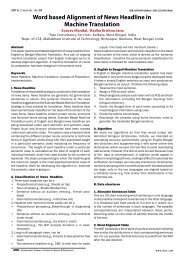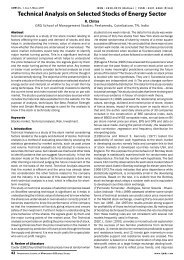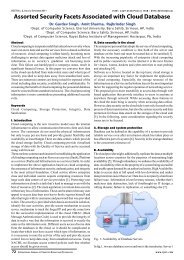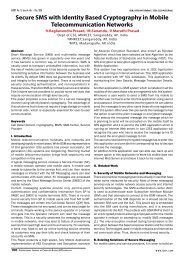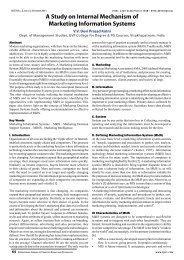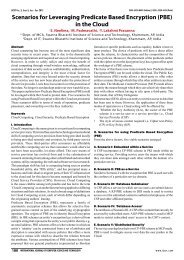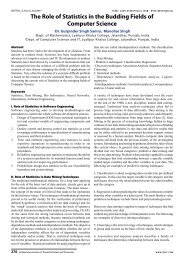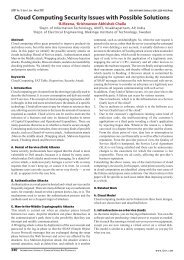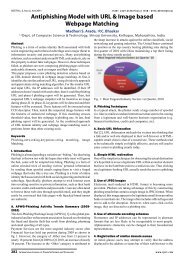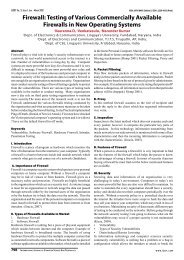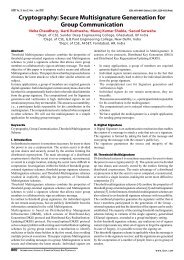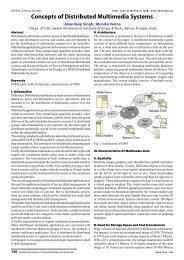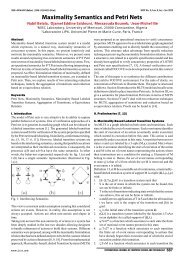A Text to Speech System for Hindi using English Language - IJCST
A Text to Speech System for Hindi using English Language - IJCST
A Text to Speech System for Hindi using English Language - IJCST
You also want an ePaper? Increase the reach of your titles
YUMPU automatically turns print PDFs into web optimized ePapers that Google loves.
<strong>IJCST</strong> Vol. 2, Issue 3, September 2011<br />
ISSN : 2229-4333(Print) | ISSN : 0976-8491(Online)<br />
A <strong>Text</strong> <strong>to</strong> <strong>Speech</strong> <strong>System</strong> <strong>for</strong> <strong>Hindi</strong> <strong>using</strong> <strong>English</strong> <strong>Language</strong><br />
1 A. Chauhan, 2 Vineet Chauhan, 3 Surendra P. Singh, 4 Ajay K. Tomar, 5 Himanshu Chauhan<br />
1,2,4<br />
Phonics Group of Institutions, Roorkee, Uttrakhand, India<br />
3<br />
Indian Institute of Technology, Roorkee, India<br />
5<br />
College of Engineering Roorkee, Roorkee, Uttrakhand, India<br />
Abstract<br />
The Paper describes the concept of <strong>Text</strong> <strong>to</strong> <strong>Speech</strong> <strong>System</strong> <strong>for</strong><br />
<strong>Hindi</strong> <strong>using</strong> the <strong>English</strong> <strong>Language</strong> or Word. Now day’s mostly<br />
Indian users write the text or E-mail, input string in instant chatting,<br />
and use the <strong>English</strong> word or language <strong>for</strong> writing scrap or messages<br />
<strong>for</strong> social networking in <strong>Hindi</strong> <strong>using</strong> <strong>English</strong> letter. Such as on<br />
facebook, orkut, GTalk, or other messenger <strong>for</strong> chatting. The text<br />
<strong>to</strong> speech system converts the input text in<strong>to</strong> the desired speech,<br />
the system is <strong>using</strong> <strong>for</strong> , <strong>to</strong> reading the user input text, speak aloud<br />
in <strong>Hindi</strong> which is write in the <strong>English</strong> word.<br />
Keyword<br />
<strong>Text</strong>-<strong>to</strong>-<strong>Speech</strong> (TTS) Synthesis, Concatenative <strong>Speech</strong> Synthesis,<br />
Unit Selection Based <strong>Speech</strong> Synthesis, QWERTY Keyboard.<br />
I. Introduction<br />
<strong>Text</strong> <strong>to</strong> speech <strong>System</strong> is most widely used system in speech<br />
technology. We have various text <strong>to</strong> speech synthesizer systems<br />
available like Festival, Multilingual and Flite etc. A <strong>Text</strong>-To-<br />
<strong>Speech</strong> (TTS) systems a computer-based system that should be<br />
able <strong>to</strong> read any text aloud, whether it was directly introduced<br />
in the computer by an opera<strong>to</strong>r or scanned and submitted <strong>to</strong> an<br />
Optical Character Recognition (OCR) system. <strong>Speech</strong> synthesis<br />
is a process where verbal communication is replicated through an<br />
artificial device. A computer that converts text <strong>to</strong> speech is one<br />
kind of speech synthesizer. In the business world, such situations<br />
are very common, especially <strong>for</strong> telephone transactions. Without<br />
text-<strong>to</strong>-speech (TTS) alternatives, business owners would have<br />
<strong>to</strong> spend money hiring even more cus<strong>to</strong>mer service personnel.<br />
Synthesized solutions avoid this problem, since everything is<br />
done by computer, not a human being. A device that is used <strong>to</strong><br />
translate text characters in<strong>to</strong> sounds that approximate the sound<br />
of human speech. Depending on the level of sophistication of the<br />
individual device, the sounds produced may be somewhat stilted<br />
and artificial sounding, or sound very much like the voice of a<br />
real person. The concept of speech synthesis has been around<br />
<strong>for</strong> centuries, but only in recent decades has the process become<br />
available <strong>to</strong> the general public. It is the digitized audio rendering<br />
of computer text in<strong>to</strong> speech. TTS software can read text from a<br />
document, Web page or e-Book, generating synthesized speech<br />
through a computer’s speakers. TTS functionality so that a writer<br />
can assign different voices <strong>to</strong> characters in his or her script. Today’s<br />
, mail is the most recently used technique <strong>for</strong> the internet users ,<br />
also sometimes written as E-mail, is simply the shortened <strong>for</strong>m<br />
of electronic mail, a pro<strong>to</strong>col <strong>for</strong> receiving, sending, and s<strong>to</strong>ring<br />
electronic messages. Email has gained popularity with the spread<br />
of the Internet. In many cases, email has become the preferred<br />
method of communication. Mostly Indian users are used the<br />
mix words in the mail or written mail, used the <strong>Hindi</strong> word or<br />
sentence in <strong>English</strong> language. And most of users are used the same<br />
<strong>English</strong> letter, word and sentence <strong>for</strong> <strong>Hindi</strong>. The other important<br />
technologies like mobile phones are used the <strong>Hindi</strong> word <strong>for</strong><br />
SMS (Short Message Service). The users create the massages<br />
<strong>for</strong> <strong>to</strong> exchanging the in<strong>for</strong>mation <strong>to</strong> each other <strong>using</strong> <strong>Hindi</strong> that<br />
is writing in <strong>English</strong>. A text-<strong>to</strong>-speech synthesizer is a system that<br />
takes as an input and au<strong>to</strong>matically produces the corresponding<br />
322 International Journal of Computer Science and Technology<br />
speech. It can be used <strong>for</strong> variety of applications such as Email<br />
reader, text reader etc. <strong>using</strong> text <strong>to</strong> speech system. <strong>Text</strong> <strong>to</strong> speech<br />
systems are increasingly becoming an essential component of<br />
different type of computing systems. Also known as an artificial<br />
voice synthesizer, a text <strong>to</strong> speech system can produce human<br />
voice artificially based on a given string. Developing a text <strong>to</strong><br />
speech system <strong>for</strong> a language that can support inputs in other<br />
languages can be helpful not only <strong>to</strong> the users know that language<br />
but are not familiar with its relative keyboard layout but also <strong>to</strong><br />
international users that do not know that language at all and can<br />
hence type in that language <strong>using</strong> their local language keyboard<br />
layout. Gayatri is a <strong>Hindi</strong> text <strong>to</strong> speech system <strong>for</strong> such a scenario<br />
in which the input string comes in <strong>for</strong>m of an <strong>English</strong> sentence<br />
or word far-away from the regular <strong>Hindi</strong> sentence or word. This<br />
development in which a <strong>Hindi</strong> sentence or word is being type in<br />
<strong>English</strong> is a common practice on the World Wide Web. Users prefer<br />
this since they are more common and com<strong>for</strong>table with an <strong>English</strong><br />
keyboard layout rather than a <strong>Hindi</strong> keyboard layout. So the users<br />
can type <strong>Hindi</strong> sentences or words in <strong>English</strong> language and feed<br />
it in<strong>to</strong> the TTS engine <strong>to</strong> be converted <strong>to</strong> speech. The system also<br />
supports a cus<strong>to</strong>m developed <strong>Hindi</strong> keyboard layout <strong>for</strong> <strong>English</strong><br />
or QWERTY keyboards <strong>to</strong> type sentences in <strong>Hindi</strong> language <strong>using</strong><br />
the QWERTY keyboard. 21st century is a century of revolution in<br />
Artificial Intelligence and Human Machine Interface <strong>System</strong>s and<br />
Natural <strong>Language</strong> Processing (NPL). <strong>Text</strong> To <strong>Speech</strong> Technology<br />
is a branch of Artificial Intelligence. <strong>Text</strong> To <strong>Speech</strong> Synthesis is<br />
a voice/ speech technology in which raw text is converted in<strong>to</strong><br />
audible speech. <strong>Text</strong> To <strong>Speech</strong> (TTS) is a process through which<br />
input text is analyzed, processed, and unders<strong>to</strong>od and then the text<br />
is rendered as digital audio and then spoken. The TTS are consist<br />
of two major components:<br />
• Natural <strong>Language</strong> Processing (NLP)<br />
• Digital Signal Processing (DSP).<br />
The process of TTS conversion allows the trans<strong>for</strong>mation of a<br />
string of phonetic and prosodic symbols in<strong>to</strong> a synthetic speech<br />
signal. The quality of the result produced by a TTS synthesizer is<br />
a function of the quality of the string, as well as of the quality of<br />
the generation process. The most important qualities of a speech<br />
synthesis system are naturalness and intelligibility. Naturalness<br />
describes how closely the output sounds like human speech, while<br />
intelligibility is the ease with which the output is unders<strong>to</strong>od. The<br />
ideal speech synthesizer is both natural and intelligible. <strong>Speech</strong><br />
synthesis systems usually try <strong>to</strong> maximize both characteristics.<br />
The two primary technologies <strong>for</strong> generating synthetic speech<br />
wave<strong>for</strong>ms are concatenative synthesis and <strong>for</strong>mant synthesis.<br />
Each technology has strengths and weaknesses, and the intended<br />
uses of a synthesis system will typically determine which approach<br />
is used. The basic types of synthesis system the following are:<br />
• Formant<br />
• Concatenated<br />
• Prerecorded<br />
A. Concatenative Synthesis<br />
Concatenative synthesis is based on the concatenation (or stringing<br />
<strong>to</strong>gether) of segments of recorded speech. Generally, concatenative<br />
synthesis produces the most natural-sounding synthesized speech.<br />
www.ijcst.com
ISSN : 2229-4333(Print) | ISSN : 0976-8491(Online)<br />
However, differences between natural variations in speech and the<br />
nature of the au<strong>to</strong>mated techniques <strong>for</strong> segmenting the wave<strong>for</strong>ms<br />
sometimes result in audible glitches in the output. There are three<br />
main sub-types of concatenative synthesis.<br />
1. Unit Selection Synthesis<br />
Unit selection synthesis uses large databases of recorded speech.<br />
During database creation, each recorded utterance is segmented<br />
in<strong>to</strong> some or all of the following: individual phones, diphones,<br />
half-phones, syllables, morphemes, words, phrases, and sentences.<br />
Typically, the division in<strong>to</strong> segments is done <strong>using</strong> a specially<br />
modified speech recognizer set <strong>to</strong> a required arrangement mode with<br />
some physical correction afterward, <strong>using</strong> visual representations<br />
such as the wave<strong>for</strong>m and spectrogram. An index of the units in<br />
the speech database is then created based on the segmentation and<br />
acoustic parameters like the fundamental frequency (pitch), duration,<br />
position in the syllable, and neighboring phones. At runtime, the<br />
desired target utterance is created by determining the best chain of<br />
candidate units from the database (unit selection). This process is<br />
typically achieved <strong>using</strong> a specially weighted decision tree. Unit<br />
selection provides the greatest naturalness, because it applies only<br />
a small amount of Digital Signals Processing (DSP) <strong>to</strong> the recorded<br />
speech. DSP often makes recorded speech sound less natural,<br />
although some systems use a small amount of signal processing<br />
at the point of concatenation <strong>to</strong> smooth the wave<strong>for</strong>m. The output<br />
from the best unit-selection systems is often indistinguishable<br />
from real human voices, especially in contexts <strong>for</strong> which the TTS<br />
system has been tuned. However, maximum naturalness typically<br />
require unit-selection speech databases <strong>to</strong> be very large, in some<br />
systems ranging in<strong>to</strong> the gigabytes of recorded data, representing<br />
dozens of hours of speech. Also, unit selection algorithms have<br />
been known <strong>to</strong> select segments from a place that results in less<br />
than ideal synthesis (e.g. minor words become unclear) even when<br />
a better choice exists in the database.<br />
2. Diphone Synthesis<br />
Diphone synthesis uses a minimal speech database containing<br />
all the diphones (sound-<strong>to</strong>-sound transitions) occurring in a<br />
language. The number of diphones depends on the phonotactics of<br />
the language: <strong>for</strong> example, Spanish has about 800 diphones and<br />
German about 2500. In diphone synthesis, only one example of<br />
each diphone is contained in the speech database. The quality of<br />
the resulting speech is generally worse than that of unit-selection<br />
systems, but more natural-sounding than the output of <strong>for</strong>mant<br />
synthesizers. Diphone synthesis suffers from the sonic glitches<br />
of concatenative synthesis and the robotic-sounding nature<br />
of <strong>for</strong>mant synthesis, and has few of the advantages of either<br />
approach other than small size. As such, its use in commercial<br />
applications is declining, although it continues <strong>to</strong> be used in<br />
research because there are a number of freely available software<br />
implementations.<br />
B. Formant Synthesis<br />
Formant synthesis does not use human speech samples at runtime.<br />
Instead, the synthesized speech output is created <strong>using</strong> additive<br />
synthesis and an acoustic model (physical modelling synthesis)<br />
Parameters such as fundamental frequency, voicing, and noise levels<br />
are varied over time <strong>to</strong> create a wave<strong>for</strong>m of artificial speech. This<br />
method is sometimes called rules-based synthesis; however, many<br />
concatenative systems also have rules-based components. Many<br />
systems based on <strong>for</strong>mant synthesis technology generate artificial,<br />
robotic-sounding speech that would never be mistaken <strong>for</strong> human<br />
speech. However, maximum naturalness is not always the goal of<br />
www.ijcst.com<br />
<strong>IJCST</strong> Vol. 2, Issue 3, September 2011<br />
a speech synthesis system, and <strong>for</strong>mant synthesis systems have<br />
advantages over concatenative systems. Formant synthesizers are<br />
usually smaller programs than concatenative systems because they<br />
do not have a database of speech samples.<br />
C. Prerecorded Synthesis<br />
In prerecorded synthesis record large paragraphs of <strong>Hindi</strong> words<br />
(commonly used <strong>Hindi</strong> vocabulary) in a continuous rhythm with<br />
small gap between two successive words in <strong>for</strong>m of a silence and<br />
save them as sound files on the database. We maintain a large<br />
central database containing different tables that act as a lookup<br />
reposi<strong>to</strong>ry <strong>for</strong> the different <strong>Hindi</strong> words supported by TTS system.<br />
And save the in<strong>for</strong>mation of a given <strong>Hindi</strong> word in the database<br />
according <strong>to</strong> its word length. The synthesis use the different tables<br />
are named from 1 <strong>to</strong> 20. These table numbers indicate nothing<br />
else but the length of the <strong>Hindi</strong> words. Hence if we are looking<br />
<strong>for</strong> a <strong>Hindi</strong> word of word length 5 in the database, then the search<br />
must be per<strong>for</strong>med only in the table 5, providing an efficient and<br />
fast way <strong>to</strong> search the data from database. If a match is found in<br />
the database <strong>for</strong> that word, we read from database.<br />
II. Why a <strong>Text</strong> <strong>to</strong> <strong>Speech</strong> <strong>System</strong>?<br />
<strong>Text</strong>-<strong>to</strong>-<strong>Speech</strong> (TTS) conversion is a technology that enables<br />
au<strong>to</strong>matic systems <strong>to</strong> convert text, <strong>to</strong> natural-sounding speech.<br />
TTS technology is useful in telephony applications, especially in<br />
reading text that changes dynamically, such as electronic mail,<br />
Internet content etc. Some typical applications of TTS technology<br />
are:<br />
• Cus<strong>to</strong>mer support dialog systems e.g. fully or partially<br />
au<strong>to</strong>mated help desks.<br />
• Unified Messaging <strong>System</strong>s, specifically email reading<br />
systems.<br />
• Interactive voice response (IVR) systems, e.g. banking<br />
applications.<br />
• Elementary and Applied Research.<br />
• Telecommunications and Multimedia.<br />
• Educational State.<br />
• Screen reader programs <strong>for</strong> the visually impaired.<br />
The aim of a text <strong>to</strong> speech system is <strong>to</strong> convert the given input<br />
text in<strong>to</strong> a corresponding spoken wave<strong>for</strong>m. <strong>Text</strong> processing and<br />
speech generation are two main components of a text <strong>to</strong> speech<br />
system. The objective of the text processing component is <strong>to</strong><br />
process the given input text and produce appropriate sequence of<br />
phonemic units. These phonemic units are realized by the speech<br />
generation component either by synthesis from parameters or<br />
by selection of a unit from a large speech corpus. For natural<br />
sounding speech synthesis, it is essential that the text processing<br />
component produce an appropriate sequence of phonemic units<br />
corresponding <strong>to</strong> an input text.<br />
III. <strong>Speech</strong> Synthesis Methodologies<br />
The entire process of synthesizing speech can be divided in<strong>to</strong><br />
two broad parts:<br />
A. Analysis and<br />
B. Synthesis<br />
The two mostly known methods of speech synthesis are <strong>for</strong>mant<br />
synthesis and concatenation synthesis. We are discussing these in<br />
this section. However, analysis part is more or less the same <strong>for</strong><br />
either technique and is there<strong>for</strong>e discussed independently.<br />
International Journal of Computer Science and Technology 323
<strong>IJCST</strong> Vol. 2, Issue 3, September 2011<br />
ISSN : 2229-4333(Print) | ISSN : 0976-8491(Online)<br />
In this approach, the syllabication algorithm breaks a word<br />
such that there are minimum numbers of breaks in the word, as<br />
minimum number of joins will have fewer artefacts. The algorithm<br />
dynamically looks <strong>for</strong> polysyllable units making up the word,<br />
cross checks the database <strong>for</strong> availability of units, and then breaks<br />
the word accordingly. If polysyllable units are not available, then<br />
algorithm naturally picks up smaller units. This mean, if database<br />
is populated with all available phones of language along with<br />
syllable units, algorithm falls back on phones if bigger units are<br />
not available. A syllable types are: V, VC, CV, VCC, CVC, CCVC<br />
and CVCC etc. where V and C represent vowel and consonant<br />
respectively that are used <strong>for</strong> languages. There are twelve vowel<br />
found in Devanagari language , the fig. 2. show the 12 devanagari<br />
vowels. Devanagari script has about 36 consonants. Out of these<br />
36 consonants, first 30 is divided in<strong>to</strong> 6 groups. Each group has<br />
five letters (sounds) and these sounds, in turn, are divided in<strong>to</strong><br />
three other subgroups.<br />
Fig.1: Comparison between speech synthesis systems<br />
IV. <strong>System</strong> Overview<br />
Now days, Indian users prefer <strong>to</strong> type <strong>Hindi</strong> sentences in <strong>English</strong><br />
language. This fact is established all over the web especially on the<br />
social networking websites such as Facebook, Orkut etc. and the<br />
internet messengers like GoogleTalk, Yahoo messenger, Rediff Bol<br />
etc. Users do this because they are used <strong>to</strong> the <strong>English</strong> QWERTY<br />
keyboard and due <strong>to</strong> non-familiarity and availability of the <strong>Hindi</strong><br />
keyboard. The <strong>Hindi</strong> text <strong>to</strong> speech system <strong>for</strong> such a scenario<br />
in which the input is in <strong>for</strong>m of <strong>English</strong> typed <strong>Hindi</strong> sentences<br />
or words. A <strong>Hindi</strong> word being typed in <strong>English</strong> can have many<br />
different possibilities according <strong>to</strong> different users. We consider<br />
all of them <strong>for</strong> each individual word. <strong>Text</strong> <strong>to</strong> speech systems are<br />
increasingly becoming an essential component of different type of<br />
computing systems. Also known as an artificial voice synthesizer,<br />
a text <strong>to</strong> speech system can produce human voice artificially<br />
based on a given string. Developing a text <strong>to</strong> speech system <strong>for</strong> a<br />
language that can support inputs in other languages can be helpful<br />
not only <strong>to</strong> the users that know that language but are not familiar<br />
with its relative keyboard layout but also <strong>to</strong> international users<br />
that do not know that language at all and can hence type in that<br />
language <strong>using</strong> their local language keyboard layout. Gayatri is<br />
a <strong>Hindi</strong> text <strong>to</strong> speech system <strong>for</strong> such a scenario in which the<br />
input string comes in <strong>for</strong>m of an <strong>English</strong> sentence or word apart<br />
from the regular <strong>Hindi</strong> sentence or word. This scenario in which<br />
a <strong>Hindi</strong> sentence or word is being type in <strong>English</strong> is a common<br />
practice on the World Wide Web. Users prefer this since they are<br />
more familiar and com<strong>for</strong>table with an <strong>English</strong> keyboard layout<br />
rather than a <strong>Hindi</strong> keyboard layout. So the users can type <strong>Hindi</strong><br />
sentences or words in <strong>English</strong> language and feed it in<strong>to</strong> the TTS<br />
engine <strong>to</strong> be converted <strong>to</strong> speech.<br />
A. <strong>Text</strong> Processing<br />
The text is input in <strong>Hindi</strong> Using <strong>English</strong> Letter or <strong>Language</strong><br />
that is follow the <strong>Hindi</strong> word. We are type the text in this <strong>for</strong>m<br />
that is, “mera naam anusha hai”. The text is input as <strong>Hindi</strong> but<br />
use the <strong>English</strong> letter. The <strong>Text</strong> processing module consists of<br />
preprocessing and syllabication modules. The text in transliterated<br />
<strong>for</strong>m is preprocessed <strong>to</strong> remove invalid characters in the text. And<br />
also, preprocessing module adds phrase break indica<strong>to</strong>rs <strong>to</strong> the<br />
text based on full s<strong>to</strong>ps and case markers. The preprocessed text<br />
is further passed on <strong>to</strong> the syllabication module.<br />
B. Syllabication<br />
324 International Journal of Computer Science and Technology<br />
Fig. 2: Devanagari vowels<br />
C. Unit Selection<br />
It consists of basic units of varying sizes at syllable and phone<br />
levels. Each instance of the units is s<strong>to</strong>red along with prosodic and<br />
linguistic features like pitch, duration, energy, phonetic context<br />
and syllable position in the word. And the issue of unit selection<br />
search concerns how <strong>to</strong> find this one best sequence of units from<br />
all the possible sequences. To give some idea of the scale of this,<br />
consider a usual case where we have say 20 words in the input<br />
sentence which gives rise <strong>to</strong> 100 diphone items in the specification.<br />
If we have 100 units <strong>for</strong> each diphone, this means that there are<br />
100100 = 10200 unique sequences of diphones may possible.<br />
D. Concatenation<br />
Since all the <strong>Hindi</strong> words cannot be recorded we follow a different<br />
approach <strong>for</strong> words that are not available in the database. We<br />
follow the approach of concatenation of <strong>Hindi</strong> words and diphones<br />
<strong>to</strong> <strong>for</strong>m a new word in real-time and play it. Selected speech units<br />
are modified according <strong>to</strong> the predicted prosody and concatenated<br />
<strong>to</strong> <strong>for</strong>m a single speech file. This module of the TTS system is<br />
responsible <strong>for</strong> finding the boundary values of a syllable sound<br />
in the recorded sound file, from the database. The input text that<br />
is segmented in<strong>to</strong> words is passed <strong>to</strong> this module. First search in<br />
the database is made <strong>to</strong> look if the word as such is present in the<br />
database. If it is present, the starting and end positions of word<br />
sound in the recorded sound file, are returned from the database,<br />
otherwise, syllabification module is called <strong>to</strong> segment the word<br />
in<strong>to</strong> syllables. Now these syllables are searched in the database.<br />
First the search is made according <strong>to</strong> the position (starting, middle<br />
or end) of the syllable in the word. If search is successful <strong>for</strong><br />
that particular position of syllable, starting and end positions of<br />
syllable sound in recorded sound file are returned from database.<br />
If there is no entry <strong>for</strong> that particular position of syllable in the<br />
database, then that syllable is searched <strong>for</strong> any position. If the<br />
syllable is found at any location, the starting and end positions of<br />
its sound in the recorded sound file, are returned from the database.<br />
Otherwise this syllable is segmented further in<strong>to</strong> smaller speech<br />
units and these units are searched in the database. Concatenation<br />
of different words and diphones can result in<strong>to</strong> <strong>for</strong>mation of any<br />
word <strong>for</strong> a particular language. The each <strong>Hindi</strong> word is s<strong>to</strong>red in<br />
the database in the following ways:<br />
www.ijcst.com
ISSN : 2229-4333(Print) | ISSN : 0976-8491(Online)<br />
• Actual <strong>Hindi</strong> Word<br />
This is the real <strong>Hindi</strong> word when typed through our tradition<br />
developed <strong>Hindi</strong> keyboard.<br />
• <strong>English</strong> Word Possibilities<br />
Followed by the real <strong>Hindi</strong> word and a comma, <strong>English</strong> word<br />
possibilities are the various possibilities in <strong>for</strong>m of comma<br />
separated values of actual <strong>Hindi</strong> word when typed in through the<br />
<strong>English</strong> keyboard. During concatenation, there will be a point of<br />
silence between any two consecutive diphones/words resulting<br />
in inaccuracy and non-continuity in playing out the complete<br />
word in a continuous flow. This silence is due <strong>to</strong> inability of the<br />
sound player <strong>to</strong> play one sound just next <strong>to</strong> another. To eliminate<br />
such errors we follow an approach as we call it selective focus.<br />
Selective focus makes sure that when the first diphone/word<br />
is been played out by the sound player, it must be followed by<br />
playing the sound of the last letter of that diphone continuously<br />
until the next consecutive diphone /word is concatenated with it<br />
and played.<br />
E. Prosody<br />
In prosody module the prosodic features like pitch, duration,<br />
and stress, emotions, intensity etc. are predicted <strong>for</strong> the selected<br />
syllables. During recording of prompts, the prosody with<br />
which voice talent reads the prompt varies over the length of<br />
the recording. In addition, syllables used in concatenation are<br />
picked from different contexts. Because of these reasons, audible<br />
discontinuity due <strong>to</strong> discontinuous prosodic con<strong>to</strong>urs is perceived<br />
in the synthesized speech. To correct these prosodic con<strong>to</strong>urs,<br />
Classification and Regression Tree (CART) is used in predicting<br />
prosody <strong>for</strong> the selected units. Prosodic features can be divided<br />
in<strong>to</strong> several levels such as syllable, word, and phrase level etc.. For<br />
example, at word level vowels are more intense than consonants.<br />
At phrase level correct prosody is more difficult <strong>to</strong> produce than<br />
at the word level.<br />
F. Database Design<br />
This system used databases of pre-selected units, such as phones,<br />
diphones, syllables or demi-syllables. The creation of these<br />
databases involved selecting a single unit <strong>for</strong> inclusion in the<br />
system–representative of all possible occurrences. To cater <strong>for</strong><br />
all possible segmental or prosodic contexts, the unit needs <strong>to</strong><br />
be as neutral as possible. The inconsistency of data is that the<br />
more general purpose the unit the more abstract it is and the<br />
less natural. A phone-based system provides the worst situation,<br />
with just a hundred or so units. Here the idea is <strong>to</strong> include as<br />
many non-neutral units as possible, and choose the appropriate<br />
one online–that is, the units are selected at runtime; hence the<br />
need <strong>for</strong> efficient search techniques. TTS on initialization loads<br />
entire database containing syllable segments and their feature<br />
descriptions in<strong>to</strong> a data structure. The data is s<strong>to</strong>red in a hash<br />
table. Syllable segments and their feature descriptions are s<strong>to</strong>red<br />
<strong>using</strong> linked lists under hash list.<br />
V. QWERTY keyboard<br />
QWERTY is the most common modern-day keyboard layout. The<br />
name comes from the first six letters (keys) appearing in the <strong>to</strong>p<br />
letter row of the keyboard, read left <strong>to</strong> right: Q-W-E-R-T-Y. The<br />
QWERTY design is based on a layout created by Chris<strong>to</strong>pher<br />
Latham Sholes. The use and adoption of the QWERTY keyboard<br />
is often viewed as one of the most important case studies in open<br />
standards because of the widespread, collective adoption and<br />
use of the product, particularly in the United States and Asian<br />
Countries. Through this keyboard we can write the <strong>Hindi</strong> language<br />
www.ijcst.com<br />
<strong>using</strong> an <strong>English</strong> letter or word. The “fig.3” has shown the layout<br />
of the Keyboard.<br />
Fig.3: Layout of the QWERTY Keyboard<br />
<strong>IJCST</strong> Vol. 2, Issue 3, September 2011<br />
VI. Conclusion<br />
The <strong>Text</strong> <strong>to</strong> <strong>Speech</strong> <strong>System</strong> <strong>for</strong> <strong>Hindi</strong> <strong>using</strong> <strong>English</strong> <strong>Language</strong> is<br />
able <strong>to</strong> speak a loud <strong>Hindi</strong> word which is typed in <strong>English</strong>. The<br />
system read the input data in a natural <strong>for</strong>m. The user types the<br />
input string and the system reads it from the database or data<br />
s<strong>to</strong>re where the words, phones, diphones, triphone are s<strong>to</strong>red. The<br />
QWERTY keyboards is the most widely accepted keyboard in<br />
the world so typing in <strong>English</strong> even the local languages becomes a<br />
fast, easy and effective method of communication. The system also<br />
supports a cus<strong>to</strong>m developed <strong>Hindi</strong> keyboard layout <strong>for</strong> <strong>English</strong><br />
QWERTY keyboards <strong>to</strong> type sentences in <strong>Hindi</strong> language <strong>using</strong><br />
the <strong>English</strong>. The system has been developed <strong>for</strong>, <strong>to</strong> run on a web<br />
based interfaces and mobile phones etc.<br />
References<br />
[1] Black et al., 2001 Black A, Taylor P, Caley R (2001), "The<br />
Festival speech synthesis system: system documentation".<br />
University of Edinburgh [Online] Available : http://www.<br />
cstr.ed.ac.ukprojects/festival/.<br />
[2] Black et al., (2001), "User Manual <strong>for</strong> the Festival <strong>Speech</strong><br />
Synthesis <strong>System</strong>", version1.4.3 [Online] Available : http://<br />
fife.speech.cs.cmu.edu /festival/cstr/festival/1.4.3/.<br />
[3] Chopra D. , "Gayatri – A Fast <strong>Hindi</strong> <strong>Text</strong> To <strong>Speech</strong> <strong>System</strong><br />
with Input Support For <strong>English</strong> <strong>Language</strong>”, International<br />
Journal of In<strong>for</strong>mation Technology and Knowledge<br />
Management January-June 2011, Volume 4, No. 1, pp. 139-<br />
141<br />
[4] Du<strong>to</strong>it, “An Introduction <strong>to</strong> <strong>Text</strong>-<strong>to</strong>-<strong>Speech</strong> Synthesis,” First<br />
edition, Kluwer Academic Publishers, 1996<br />
[5] Ganapathiraju M., Balakrishnan M., Balakrishnan N., Reddy<br />
R., “Om: One <strong>to</strong>ol <strong>for</strong> many (Indian) languages,” Journal of<br />
Zhejiang University Science, vol. 6A, no. 11, pp. 1348–1353,<br />
2005.<br />
[6] Google Online <strong>Hindi</strong> <strong>to</strong> <strong>English</strong> Transliteration Tool, [Online]<br />
Available : www.google.com/transliteration.<br />
[7] Hunt A.J., Black A.W., “Unit selection in a concatenative<br />
speech synthesis system <strong>for</strong> a large speech database,” in<br />
Proceedings of IEEE Int. Conf. Acoust., <strong>Speech</strong>, and Signal<br />
Processing, 1996, pp. 373–376.<br />
[8] K. Bali, A. G. Ramakrishnan, P. P. Talukdar, S. K. Nemela,<br />
“Tools <strong>for</strong> the development of a <strong>Hindi</strong> speech synthesis<br />
system,” in 5th ISCA <strong>Speech</strong> Synthesis Workshop, Pittsburgh,<br />
USA, 2004.<br />
[9] K. Prahallad, A. W. Black, R. Kumar, R. Sangal, “Experiments<br />
with unit selection speech databases <strong>for</strong> Indian languages,” in<br />
Proceedings of National Seminar on <strong>Language</strong> Technology<br />
Tools: Implementations of Telugu, Hyderabad, India,<br />
2003.<br />
International Journal of Computer Science and Technology 325
<strong>IJCST</strong> Vol. 2, Issue 3, September 2011<br />
ISSN : 2229-4333(Print) | ISSN : 0976-8491(Online)<br />
[10] Mukhopadhyay, A. Chakraborty, S. Choudhury, M. Lahiri,<br />
A. Dey, S. Basu, A., “Shruti- an Embedded <strong>Text</strong>-<strong>to</strong>-speech<br />
<strong>System</strong> <strong>for</strong> Indian <strong>Language</strong>s” Software, IEEE Proceedings,<br />
153, Issue 2, April 2006, Page(s) 75–79.<br />
[11] P. Taylor, A.W. Black, R. Caley, “The architecture of the<br />
Festival speech synthesis system,” in 3rd ESCA Workshop<br />
on <strong>Speech</strong> Synthesis, Jenolan Caves, Australia, 1998, pp.<br />
147–151.<br />
[12] Prahallad L., Prahallad K., Ganapathiraju M., “A simple<br />
approach <strong>for</strong> building transliteration edi<strong>to</strong>rs <strong>for</strong> Indian<br />
languages,” Journal of Zhejiang University Science, vol.<br />
6A, no. 11, pp. 1354–1361, 2005.<br />
[13] Ramakrishnan, A.G. et.al., “Tools <strong>for</strong> the Development of<br />
a <strong>Hindi</strong> <strong>Speech</strong> Synthesis <strong>System</strong>”, in 5th ISCA <strong>Speech</strong><br />
Synthesis Workshop, Pittsburgh, pp. 109-114, 2004.<br />
[14] S. S. Agrawal, “Synthesizing <strong>Hindi</strong> speech <strong>using</strong> Klsyn<br />
and Hlsyn <strong>for</strong> natural sounding,” in Workshop on Spoken<br />
<strong>Language</strong> Processing, TIFR, Mumbai, 2003.<br />
[15] Veera Raghavendra, K. Prahallad, “A multilingual screen<br />
reader in Indian languages,” in National Conference on<br />
Communications (NCC), Chennai, India, 2010.<br />
[16] X. A. Furtado, A. Sen, “Synthesis of unlimited speech in<br />
Indian languages <strong>using</strong> <strong>for</strong>mant-based rules,” Sadhana, vol.<br />
21, no. 3, pp. 345–362, 1996.<br />
Amit Kumar Chauhan received his Master<br />
degree as MCA (Master of Computer<br />
Application) in 2006 from Deheradun<br />
Institute Of Technology, Deheradun<br />
(Affiliated from U.P Technical University,<br />
Lucknow). And presently working as<br />
Assistant Professor (Computer Science<br />
Deptt.) at Phonics School of Engineering,<br />
Rookee, Haridwar (Uttrakhand). He has 5<br />
years teaching experience involved in multiple research areas<br />
such as <strong>Speech</strong> processing, <strong>Text</strong> processing , Image processing,<br />
upcoming technology and various computing technology. The<br />
papers has been published 6 international and 2 national in journal,<br />
3 papers in international conferences 2 in National conferences<br />
and attended 5 national conferences / workshops.<br />
326 International Journal of Computer Science and Technology<br />
www.ijcst.com



